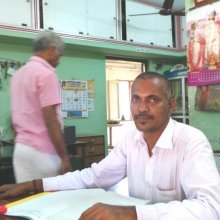Vavi, Vāvi: 3 definitions
Introduction:
Vavi means something in Jainism, Prakrit, Tamil. If you want to know the exact meaning, history, etymology or English translation of this term then check out the descriptions on this page. Add your comment or reference to a book if you want to contribute to this summary article.
Images (photo gallery)
Languages of India and abroad
Prakrit-English dictionary
Source: DDSA: Paia-sadda-mahannavo; a comprehensive Prakrit Hindi dictionary1) Vāvi (वावि) in the Prakrit language is related to the Sanskrit word: Vāpi.
2) Vāvi (वावि) also relates to the Sanskrit word: Vyāpita.
3) Vāvī (वावी) also relates to the Sanskrit word: Vāpī.
Prakrit is an ancient language closely associated with both Pali and Sanskrit. Jain literature is often composed in this language or sub-dialects, such as the Agamas and their commentaries which are written in Ardhamagadhi and Maharashtri Prakrit. The earliest extant texts can be dated to as early as the 4th century BCE although core portions might be older.
Kannada-English dictionary
Source: Alar: Kannada-English corpusVāvi (ವಾವಿ):—[noun] = ವಾವೆ [vave].
--- OR ---
Vāvi (ವಾವಿ):—[noun] a hole drilled into the earth to obtain water, petroleum, natural gas etc.; a well.
Kannada is a Dravidian language (as opposed to the Indo-European language family) mainly spoken in the southwestern region of India.
Tamil dictionary
Source: DDSA: University of Madras: Tamil LexiconVavi (வவி) noun See வவ்வி. [vavvi.] (W.)
--- OR ---
Vāvi (வாவி) noun < vapī.
1. Tank, reservoir of water; நீர்நிலை. (பிங்கலகண்டு) மன்னு தண்பொழிலும் வாவியும் [nirnilai. (pingalagandu) mannu thanpozhilum vaviyum] (நாலாயிர திவ்யப்பிரபந்தம் பெரியதி. [nalayira thivyappirapandam periyathi.] 2, 3, 10).
2. Well with a flight of steps down to the water; நடைக் கிணறு. [nadaig kinaru.]
3. Stream of water running in a river bed; ஆற்றிலோடை. வண்டார் குவளைய வாவியும் [arrilodai. vandar kuvalaiya vaviyum] (சீவகசிந்தாமணி [sivagasindamani] 337).
Tamil is an ancient language of India from the Dravidian family spoken by roughly 250 million people mainly in southern India and Sri Lanka.
See also (Relevant definitions)
Starts with: Vavia, Vaviddha, Vavidh, Vavidhana, Vavidhi, Vavijjamta, Vavilavalala, Vavili, Vavili chettu, Vavippul, Vavira, Vavisha, Vavitta, Vavitti, Vavivartana, Vavivartane, Vavivartanedappu.
Ends with: Amganavavi, Avavi, Boddanavavi, Devavi, Entiravavi, Havavi, Kavavi, Manacavavi, Mativavi, Mvavavi, Nakara-vavi, Nanavavi, Nataivavi, Padivavi, Palavi, Pancavavi, Takvavi, Teyvavi.
Full-text: Vapi, Vavippul, Nuvara-vava, Nakara-vavi, Vyapita, Manacavavi, Nataivavi, Nermpunai, Entiravavi, Niralam, Payam, Kuntam, Patama.
Relevant text
Search found 2 books and stories containing Vavi, Vaavi, Vāvi, Vāvī; (plurals include: Vavis, Vaavis, Vāvis, Vāvīs). You can also click to the full overview containing English textual excerpts. Below are direct links for the most relevant articles:
The Doctrine of Paticcasamuppada (by U Than Daing)
Folk Tales of Gujarat (and Jhaverchand Meghani) (by Vandana P. Soni)
Chapter 35 - Vikram and Khapro < [Part 5 - Rang Chee Barot]

